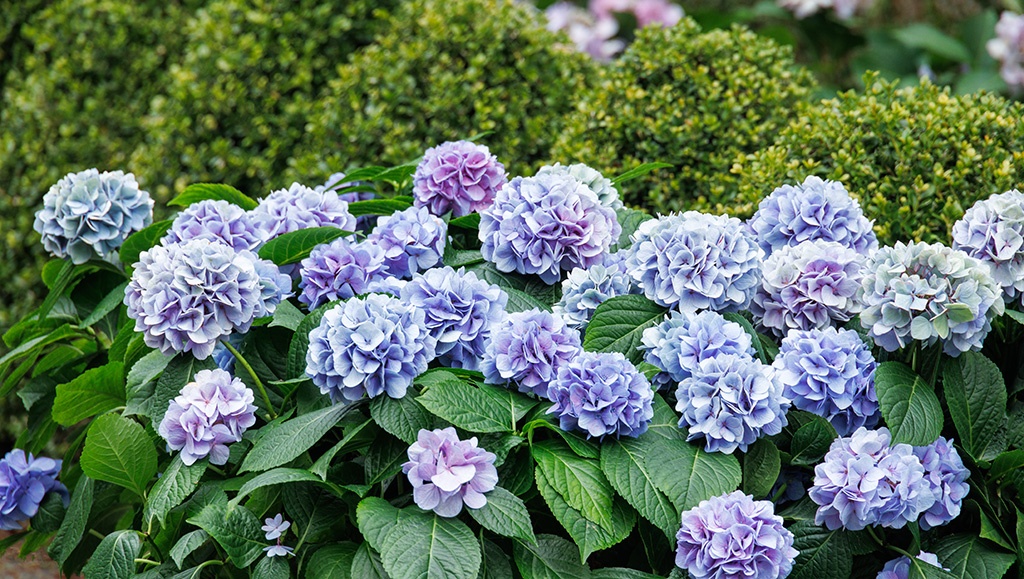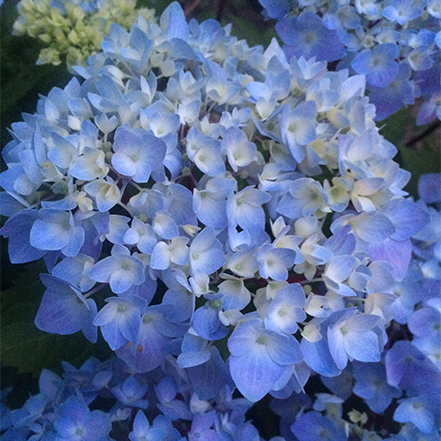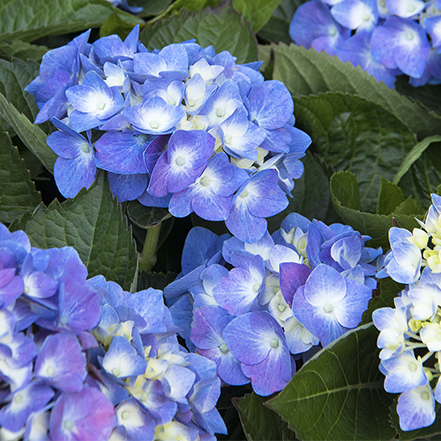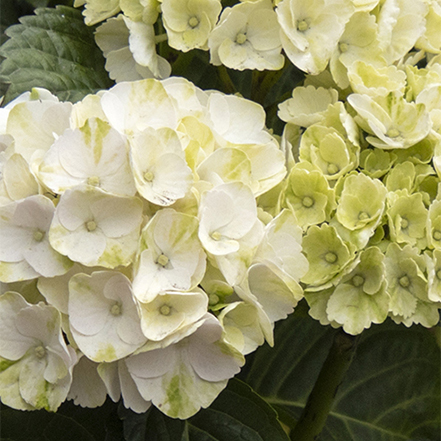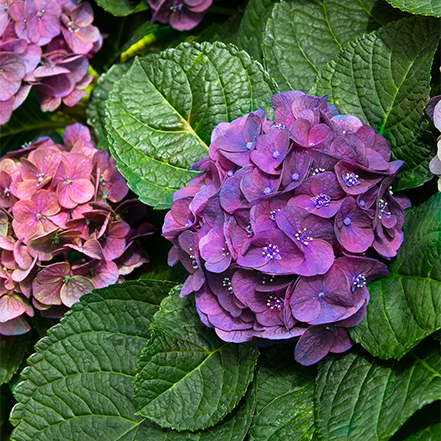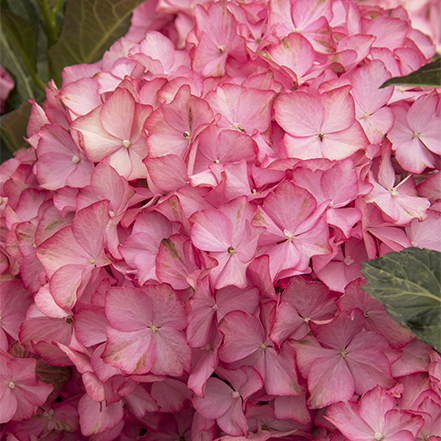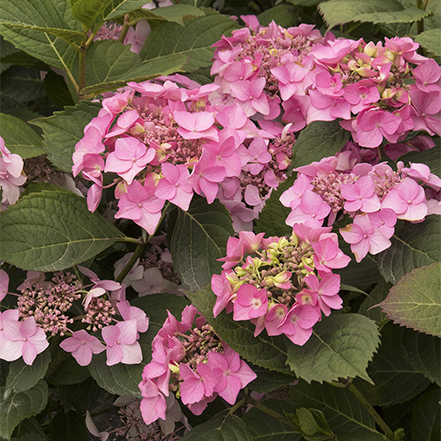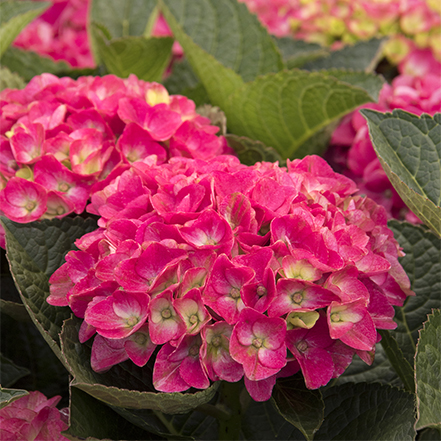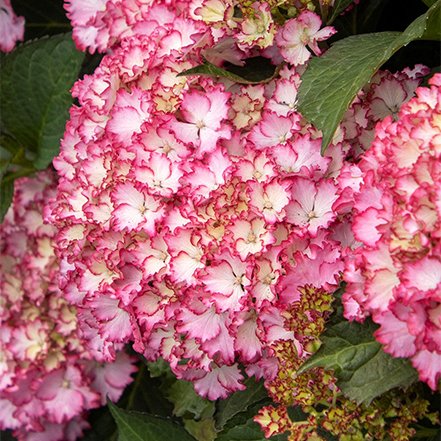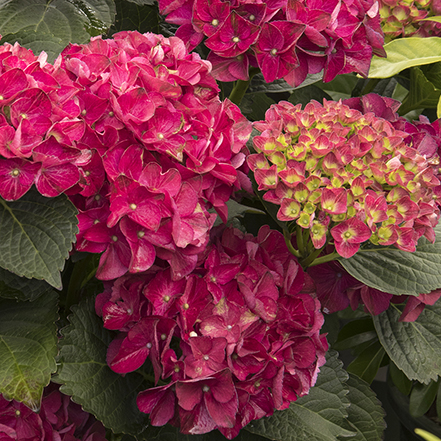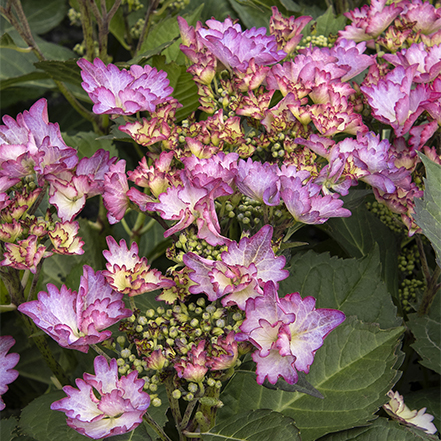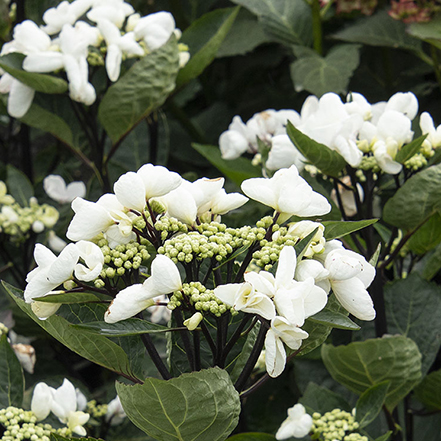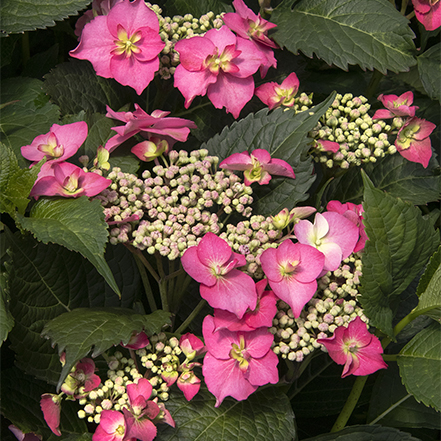With their showy flowers, lush foliage, striking color choices, and adaptability to most zones, it's no wonder that hydrangeas are favorites of gardeners across the country. But we've found that many gardeners feel stumped when it comes to how to best care for their hydrangeas to get the most blooms. For some, hydrangeas have gotten a bad reputation for being fussy. If you choose a hardy, reliable variety and plant it in the right spot, you'll find growing hydrangeas is easy. (We list the best easy-care hydrangeas at the bottom of the story).
Gardening is much more fun and relaxing when you feel confident in your approach, and get to enjoy your beautiful results. This is a clear how-to guide for hydrangea care to help you do just that.
Table of Contents
1. Planting
2. Pruning
3. Fertilizing
4. Watering
5. Changing flower color
6. Other common care questions
7. Best easy-care hydrangeas
Whether it's planting, pruning, watering, or fertilizing hydrangeas. Get all the information you need for growing hydrangeas confidently from this guide. Did we miss something? Let us know by writing to [email protected], or tag us on social media @MonroviaPlants.
1. Planting Hydrangeas
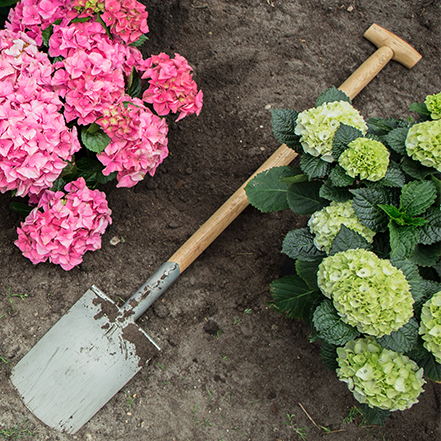
When is the best time to plant hydrangeas?
If we had to pick, we'd say spring and fall are the best times to plant hydrangeas. In spring, you'll plant macrophylla hydrangeas when in full flower for instant gratification and before summer heat comes. Planting in fall gives ample time to develop a healthy root system. (Before the burst of growth that will come in spring.) The longer and colder your winter, the earlier in fall you'll want to plant. Just remember to water your new plant through the fall and in the winter if needed.
If planting in spring or early summer, you'll want to avoid planting at the hottest time of the day, and make sure you water in well to get plants established before summer heat.
Where should you plant hydrangeas?
Most hydrangeas thrive in partial shade or sun. They especially like morning sun and afternoon shade in warmer climates, as the afternoon sun can be too harsh for them. Afternoon shade is essential in hot, dry climates. Hydrangeas make fantastic foundation plants not only because they look striking against the house, but also because they love the partial sun and shelter that the walls and eaves of a house offer. In the Midwest and other cold climates, hydrangeas can be planted in full sun. To determine what's best where you live, ask the garden center where you purchase for advice.
How do you prepare the soil for planting hydrangeas?
Hydrangeas prefer well-draining soil that's rich in organic matter. So, preparing the soil is an important step when you're planting hydrangeas. Mixing a healthy amount of compost into your soil is a great way to create the rich soil they love. You can also mix in a balanced, slow-release fertilizer to get the plant off to a great start. If you're trying to turn your hydrangeas a certain color, this is the time to add the appropriate soil amendment (more on that below).
After you plant the hydrangea into the amended soil, be sure to add a thick layer of mulch but keep it away from the trunk. Mulch will prevent weeds and maintain soil moisture. Then, give the plant a deep watering right after planting. Then again once or twice a week to keep the soil moist but not soggy (see watering tips below).
2. Deadheading and Pruning Hydrangeas
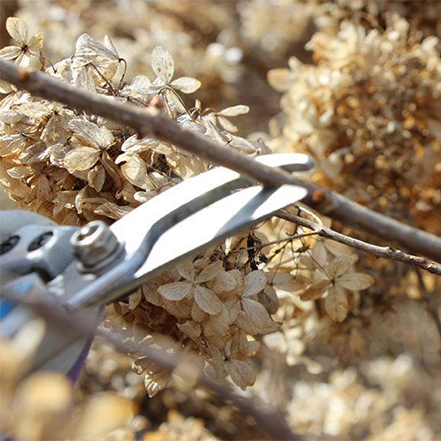
Should I cut off dead hydrangea blooms (deadhead)?
Yes (but you don't have to). The most common form that your snipping will take when it comes to caring for your hydrangeas is deadheading. This is not technically "pruning." Deadheading your hydrangea can increase bloom and help keep your hydrangeas looking neat. However, you also don't have to deadhead in order to keep your plant healthy. Some gardeners like to leave the spent flowers on their hydrangeas for seasonal interest. If you do choose to deadhead, remember to leave the flowers on as long as possible. This is because many will change color as they age.
How to deadhead your hydrangeas
Deadhead your hydrangea by cutting right above the set of leaves just below the spent flower. Avoid cutting below the first set of leaves; you don't want to accidentally cut off emerging buds.
If you find woody stems with no new leaves on them, go ahead and cut them down to the new growth. Or, cut at the base in order to give room for healthier growth. Allow the plant to put energy into that new growth.
Do hydrangeas need to be cut back every year?
No. Many hydrangeas don't need to be pruned often, or even at all. Unless you need to prune for shape and size or general health of a mature plant, you can skip pruning on reblooming hydrangeas. Cutting out dead material is important, as it keeps the plant healthy. It increases airflow and allows the plant to focus energy on creating lush new growth and beautiful flowers. Compact, easy-care varieties like those featured in #7 below will rarely need to be pruned if planted in a place where they get the right amount of sun, water, and space to grow.
If you decide that you'd like to prune your hydrangea, you should know what kind of hydrangea you have. Different hydrangea types need to be pruned at different times of the year. For reblooming macrophyllas, prune after summer bloom but not too late--by fall, they'll be setting buds for next spring. For more information, check out our in-depth guide to how and when to prune hydrangeas.
Still intimidated by pruning your hydrangea? Here’s an easy option: Don’t prune until the buds of your hydrangea start to swell in spring. Then just cut off anything above the healthiest buds at the top. Or you can snip just above healthy buds further down if you'd like to reduce the size of the plant. This technique will keep you from accidentally cutting off all of next spring's growth.
Do hydrangeas need to be cut back for winter?
No. Hydrangeas don't need to be cut back for winter. In fact, we recommend leaving them untouched for visual interest through the season. However, there are some hydrangea types that can be pruned in early fall. Also some that should be left until late winter or early spring.
The general rule is that if you have hydrangeas that form flowers on old wood (like Hydrangea macrophylla a.k.a. "Mophead" hydrangeas including reblooming hydrangeas that flower on both new and old wood). You can prune them in early fall after they are done flowering. Hydrangeas that bloom on new wood (like Hydrangea paniculata a.k.a. Panicle hydrangeas) should be pruned in late winter or early spring. Our guide to how and when to prune hydrangeas goes into detail about when to prune different hydrangea types.
Get more in-depth information about preparing your hydrangeas for winter here. You'll notice that preparing your hydrangeas for winter typically does not include pruning them.
3. Fertilizing Hydrangeas
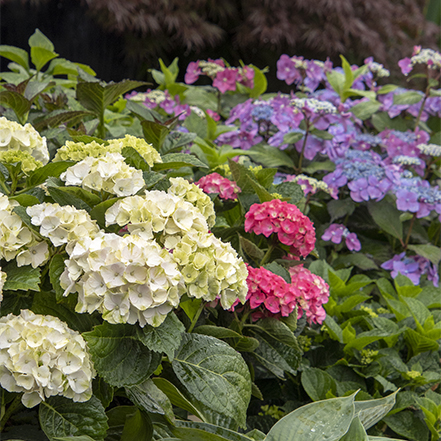
When is the best time to fertilize hydrangeas?
Different hydrangeas have different needs when it comes to fertilizer. A good "rule of thumb" fertilizer suggestion for all hydrangeas is this: Fertilize them with a well-balanced fertilizer in early spring. Adding a layer of compost and mulch will benefit your soil health, and in turn, your hydrangeas.
If you plant a hardy, compact, and improved hydrangea variety like the Seaside Serenade® hydrangeas (pictured here), fertilizer timing and amount aren't all that important. They'll thrive with very little care as long as they're planted in rich soil, partial sun/full sun depending on climate, and get enough water.
On the other hand, if you do want to fertilize your hydrangeas a bit more, follow these general guidelines. This is based on the hydrangea type you're growing:
- Smooth hydrangea varieties (H. arborescens) only need one fertilizer application in late winter or early spring.
- Oakleaf and panicle hydrangeas (H. quercifolia & H. paniculata) do well being fed twice in the season. Once in spring, and once in early summer.
- Bigleaf or "Mophead" hydrangeas (H. macrophylla) like to be fertilized little and often. Fertilize with small amounts three times throughout your growing season, starting in early spring.
What kind of fertilizer is best for hydrangeas?
The type of fertilizer that's best for you will largely depend on the soil your hydrangeas are growing in. So, the answer to this can vary depending on your region and soil conditions. However, in general, a well-balanced fertilizer is the best way to go. Don't use fertilizers that are high in nitrogen, as that can lead to fewer blooms.
4. Watering Hydrangeas
How and when to water hydrangeas
Water your hydrangeas in the morning before the heat of the sun is strong enough to quickly evaporate soil moisture. Try to avoid watering at night, which can encourage mold and mildew as the moisture sits through the cool night. Water your hydrangeas through the growing season as well as in late fall. You should also water them occasionally if you have a warm, dry winter.
Water your plants at the base, around the root zone, to avoid wasting water and getting the foliage wet.
How much water do hydrangeas need?
Deep weekly watering is usually enough (if you don't get enough rain). Although you may need to water more often in hot, dry weather. Water hydrangeas deeply and regularly in the first growing season to encourage an extensive root system. After the plant is established, water when the first inch of soil feels dry to the touch.
Can hydrangeas be watered too much?
Yes. Hydrangeas can be overwatered, and they don't do well in soggy soils. That's why it's a good idea to test the soil with your finger before providing supplemental irrigation.
5. Changing Hydrangea Flower Color
The science of changing hydrangea color comes down to soil pH. In order to change the color of your hydrangea flowers to blue, for example, you need to acidify your soil. The first thing is to get a soil test to see where your soil lands on the pH spectrum. Then, based on your soil pH and your desired flower color, follow the steps below.
Soil pH and resulting hydrangea color
- 5.0-5.5 (acidic) soil pH: Blue
- 6.0-6.5+ (neutral-alkaline) soil pH: purple to pink
Keep in mind that color changes largely depend on the cultivar and can take weeks or months to change. Some cultivars change more easily than others, and some don't change at all (more info on that below). Monrovia hydrangeas will say in the description if the color varies depending on soil pH.
Do all hydrangea flowers change color based on soil pH?
No. White-flowered hydrangeas are not typically affected by soil pH. There are also some hydrangea varieties that maintain their flower color no matter the soil pH. This includes Fire Island, Cape Hatteras, and Martha's Vineyard in the Seaside Serenade® collection (see them all below).
How to turn your hydrangeas blue
If your soil pH is 6.0-6.5, try adding the following amendments when planting a new hydrangea. Or, in early spring to create more acidic soil:
- Aluminum sulfate (according to package directions)
- Peat moss
- Coffee grounds
Then, mix and water them into the soil.
How to turn your hydrangeas pink or purple
If your soil is acidic (5.0-5.5) and you prefer pink or purple blooms to blue, try adding garden lime to your soil. Hydrangea blooms will be pink or purple with a soil pH of 6.0-6.5.
6. Other Common Hydrangea Care Questions
Do hydrangeas like sun or shade?
Hydrangeas like both sun and shade. There are a wide variety of hydrangeas with different sun exposure needs. Exposure needs can vary depending on your region and climate. However, most hydrangeas will be happy with morning sun and afternoon shade. Some hydrangeas will do well in "filtered shade," but complete shade is often not ideal for hydrangeas. They need energy from the sun to produce those amazing blooms!
The key is to check the "Light Needs" specification when searching for the next hydrangea that you bring home. On Monrovia's site, you'll find this information right below the plant description and USDA Zone. This advice is for hydranges in most climates, however and yours might be different. Check with your local garden center if in doubt.
Why isn't my hydrangea blooming?
If your hydrangea isn't blooming, consider the below possibilities. See if you can remedy the situation to encourage more blooms next season. Many of these questions are a reflection of the care tips outlined above.
Sunlight: Are your plants getting the right amount of sun? Most need at least partial sun with morning sun and afternoon shade. Some hydrangeas do well in full sun. Although most won't bloom as heavily or at all if they're living in full shade.
Water: Is your hydrangea getting enough or too much water? Overwatering and underwatering can lead to a lack of blooms. Remember to test the soil with your finger before you water. Don't water if it still feels moist. Give a deep watering if it feels dry.
Soil nutrients: Does your soil have too much nitrogen? A sure sign of too much nitrogen is if you have a lush, bushy plant with no blooms. We call this look "Salad" when there are lots of healthy leaves but no blooms. Lawn fertilizer can often cause high nitrogen in garden beds. So, check to see if any lawn fertilizer is getting into your hydrangea's soil. You can test your soil to know for sure.
Pruning: Did you prune too much or prune at the wrong time? Over-pruning and pruning in spring can cause your hydrangea to skip its bloom. Pruning in spring can cut off new buds. Pruning too far down the stem or taking out too many stems can cut out the wood. This is where new buds would form.
Weather: Did you have a cold snap? Late freezes can damage new buds and can be the culprit of missing spring flowers.
How do I care for my potted hydrangea?
Compact hydrangeas like those in the Seaside Serenade® collection are gorgeous container specimens. They also resist wilting, so are your best bet for spectacular, easy-care hydrangeas for your large containers. Typically, potted hydrangeas require a touch more shade, especially from the hot afternoon sun. You will also need to water them more than your hydrangeas in the ground. This is because the soil in a container dries out more quickly. Otherwise, follow the same guidelines for care as you do for your plants in the ground.
7. The Best Easy-Care Hydrangeas: Seaside Serenade® Hydrangea Collection
Zones 4-9
Seaside Serenade® is a spectacular collection of hydrangeas that are exclusive to Monrovia. They differ in bloom type (lacecap and mophead) and color (white, blue, pink, purple, and even ruby red). However, they all have several outstanding attributes in common.
Their thick foliage is durable and vibrant, adding to their hardy nature. Sturdy stems and long-lasting blooms make these hydrangeas superior cut flowers. Like other hydrangeas, the color of some Seaside Serenade Hydrangeas can vary depending on the soil. They are also disease-resistant and scorch-resistant on hot summer days. You can several popular varieties below.
Cape Cod
A hardy, dependable repeat bloomer with large mophead flowers, dark green leaves, and a neat, mounded, compact form. Blooms are blue in acidic soil, and pink in neutral to alkaline soil. Up to 4' tall and wide.
Cape Lookout
Amazingly long-lasting, large blooms emerge pale green, turn pure white, and then develop a light pink tinge as they mature. Resists scorch and burn on hot summer days. Up to 3.5' tall, 3' wide.
Newport
A showy rebloomer with profuse, full mophead flower clusters that mature to a deep pink on sturdy stems. Bloom color is blue-violet in acidic soils and deep pink in alkaline soils. Up to 4' tall and wide.
Hamptons
Huge, ball-shaped blooms with intense-pink florets on tough stems. Leathery dark-green foliage has a fantastic maroon color in spring and fiery cinnamon-red in fall. Up to 3.5' tall, 3' wide.
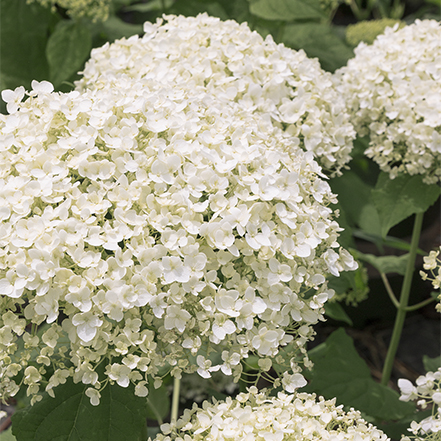
Bar Harbor
A compact and improved form of Annabelle. Sturdy, straight stems hold up the huge flower heads, even in heavy rain. Up to 4' tall and wide.
Outer Banks
Delicate lacecap blooms smother this repeat bloomer in spring and summer. Blooms are blue in acidic soil and pink in neutral to alkaline soils. Up to 4' tall and wide.
Martha's Vineyard
The sumptuous color of these pink-red mophead blooms is not influenced by soil pH. Flowers develop a lovely green tinge as they age. Up to 3.5' tall, 3' wide.
Fire Island
Long-lasting, bi-color blooms are white with rich rosy red edges that mature to deep pink. This gorgeous color combo is not affected by soil pH.
Cape Hatteras
Stunning ruby red mophead blooms are not influenced by soil pH. The lime-green center in emerging blooms offers a dramatic contrast. Up to 3.5' tall, 3' wide.
Crystal Cove
Frilly lacecap blooms have deep purple-blue edges in acidic soils. Then deep pink edges when grown in neutral or alkaline soils. This rebloomer flowers all summer long, and the flowers deepen in color as they edge. Up to 4' tall and wide.
Glacier Bay
Brilliant, crisp-white lacecap blooms pop against dramatic black stems. A compact and unique rebloomer that flowers all summer and into the fall. Up to 3' tall and wide.
Cape May
The large lacecap blooms on this compact variety are blue in acidic soils and pink in neutral to alkaline soils. Serrated leaves show touches of red and burgundy in the sun as they edge. Up to 3' tall and wide.
Get More Plant Care Tips and Guides
- Sign up for the Grow Beautifully Newsletter. You'll get gardening tips, design advice, free digital guides, and live webinar invites. Plus, new, exclusive plant information delivered straight to your inbox twice a month.
- How to put Hydrangeas to Bed for Winter
- Our Top 10 Gardening Tips
- Guide to Pruning Flowering Shrubs
- How and When to Prune Hydrangeas
- Pruning Ornamental Grasses
- How and When to Prune Lavender
- Check out the "Garden Tips" section of the blog. Here there are care guides and garden tips on a wide array of plants.





